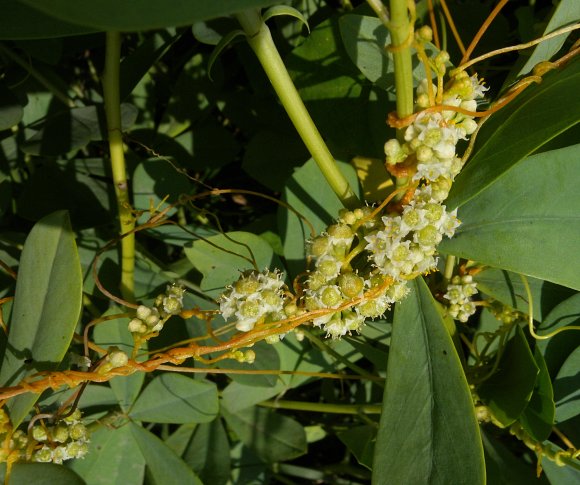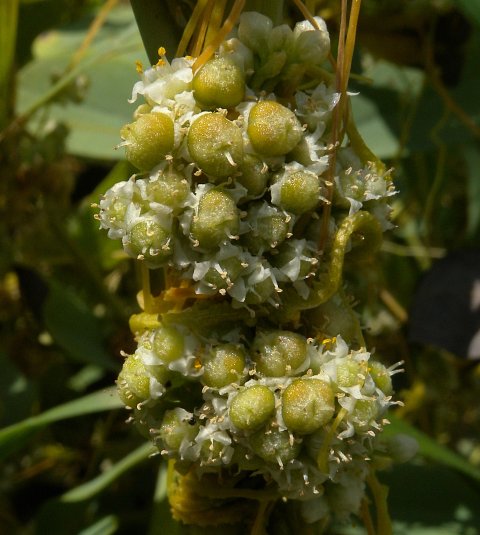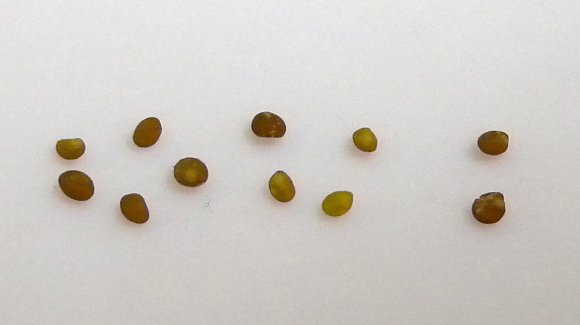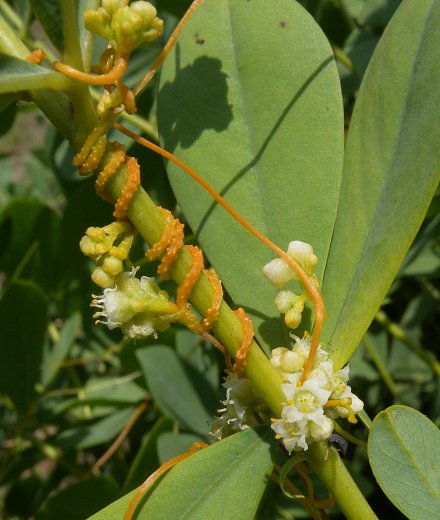
The pedicels of the flowers are light green to yellowish green, glabrous, and very short (0.5-2.0 mm. in length). These pedicels are initially terete and about 1 mm. across, but they may become swollen and angular as their flowers develop. Sometimes solitary bracts occur at the bases of flower clusters, or at the bases of individual pedicels. The blooming period occurs from mid-summer to early fall, lasting about 1 month. The flowers are either mildly fragrant or not noticeably fragrant; in the absence of cross-pollination, they are self-fertile. As the flowers continue to mature, their ovaries (developing seed capsules) swell in size, becoming 2-3.5 mm. across and subgloboid (depressed-globular) in shape. Immature seed capsules are light green, becoming yellowish orange as they begin to mature, and finally turning light brown to brown at full maturity. These capsules eventually split open irregularly to release their tiny seeds (up to 4 seeds per capsule). The seeds can spread to other areas by wind or water. Individual seeds are 1.0-1.5 mm. in length, ovoid-angular in shape, and dull yellow to brown. The seed surfaces are minutely pitted (requires 20x magnification or higher to see). While an elementary root system develops from a newly germinated seed, it soon withers away as the seedling becomes attached to a host plant.

Cultivation: This parasitic vine requires a suitable host plant in order to survive. Examples of such host plants include Baptisia australis (Blue Wild Indigo), Trifolium spp. (Clover), Medicago sativa (Alfalfa), Beta vulgaris (Sugar Beet), Solanum tuberosum (Potato), Polygonaceae (Smartweeds & Knotweeds), Allium cepa (Onion), and many others. Unsuitable host plants include Glycine max (Soybean), Equisteum arvense (Field Horsetail), and most grasses and sedges. Field Dodder occurs in drier habitats than many other Cuscuta spp. (Dodder species). It is typically found in either sandy or non-sandy areas where there is full sun or partial sun. The seeds can persist in the soil and remain viable for several years.
Range & Habitat: Field Dodder (Cuscuta campestris) is occasional throughout Illinois (see Distribution Map), where it is native. Field Dodder is one of the more common Dodder species in Illinois and it is widely distributed in North America. Habitats include banks of rivers, fields, croplands, neglected flower gardens, and waste areas. This dodder is considered a significant pest of several field crops. It is found primarily in disturbed areas.

Faunal Associations: Robertson (1929) observed small bees sucking nectar from the flowers of Cuscuta spp. (Dodder species), including Halictid bees (Lasioglossum) and plasterer bees (Colletes). Such floral visitors appear to be uncommon. Various aphids are able to suck juices from dodder vines and successfully reproduce, weakening them substantially (Harvey, 1966). Aphids that have adapted particularly well to these parasitic vines include Aphis craccivora (Cowpea Aphid), Macrosiphum euphorbiae (Potato Aphid), and Myzus persicae (Green Peach Aphid). Mammalian herbivores seem to avoid plants that are badly infested with dodder. These parasitic vines may be toxic to such animals if they are eaten in sufficient quantity. Nonetheless, should such animals consume these parasitic vines with their host plants, the seeds of dodder can pass through their digestive tracts and remain viable for several years. Because the tiny seeds of these vines become sticky when they are wet, they are probably spread to other areas by the feet or fur of mammals, the feet or feathers of birds, and the shoes of people. Agricultural machines may spread this vine into different fields through the use of contaminated crop-seed. Some materials that are used in gardens (e.g., contaminated mulch & soil) may also facilitate its spread.

Photographic Location: A flower garden at a city park in Champaign, Illinois, where this dodder infested Baptisia australis (Blue Wild Indigo).
Comments: Field Dodder (Cuscuta campestris) can be distinguished from some Dodder species (Cuscuta spp.) in Illinois by the 5-lobed corollas of its flowers: the lobes of these corollas have very acute tips that are incurved. A similar species, Common Dodder (Cuscuta gronovii), also has 5-lobed corollas, but the tips of its lobes are more blunt and they are less incurved. Field Dodder is also similar to Prairie Dodder (Cuscuta pentagona). This latter species has more angular calyces, while its seed capsules are slightly smaller in size and less depressed in shape. Prairie Dodder also has shorter anthers and shorter seeds. In the past, Field Dodder was considered a variety of Prairie Dodder (Cuscuta pentagona calycina), but they are now regarded as distinct (Costea et al., 2006; Costea et al., 2015). Other common names of Cuscuta campestris include Large-seeded Alfalfa Dodder and Golden Dodder, while another scientific synonym of this species is Cuscuta arvensis.